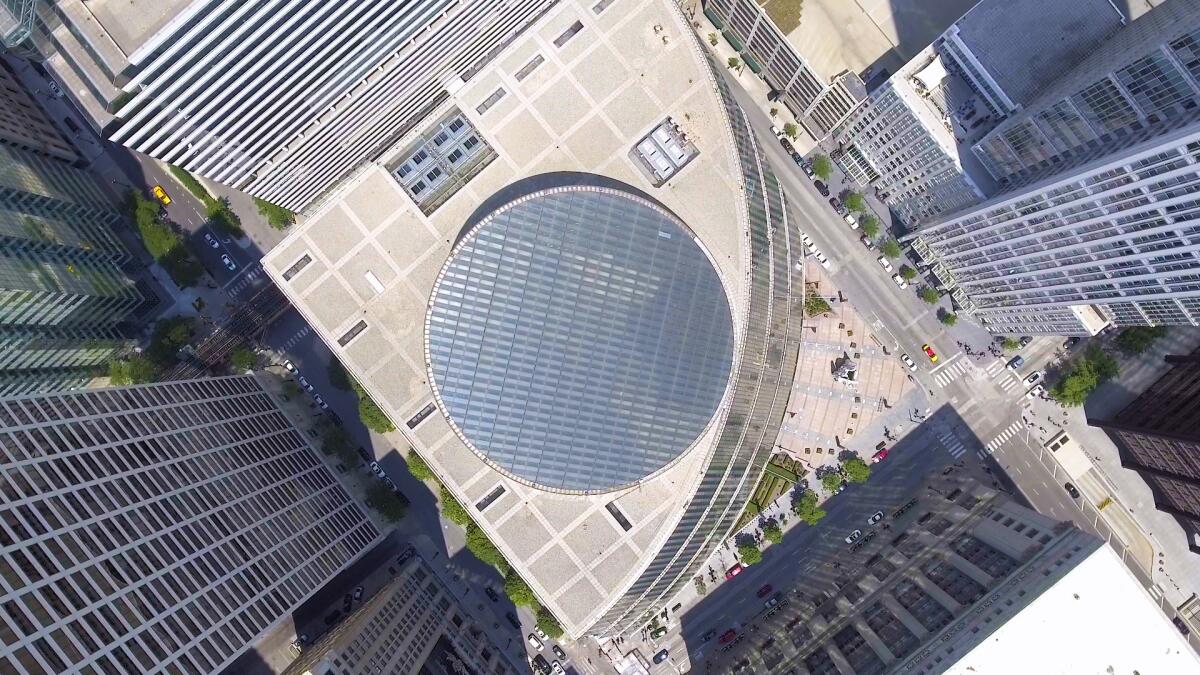Postmodern architecture at risk, Part 2: The saga shifts to Chicago
November is turning out to be Postmodernism Month in this column. Last week I tried to raise some alarm bells about a misguided new plan from architecture firm Snøhetta to remake
We turn our attention this week to Chicago, where another landmark of extroverted postmodernism,
Many of the elements of this preservation drama are depressingly familiar: building by important architect approaches middle age; falls out of fashion; suffers from deferred maintenance; begins as a result of deferred maintenance to lose whatever charm or verve it once had; falls further out of fashion; becomes demolition target. Nearly every work of architecture whose loss we mourn has essentially followed that same script, from coast to coast, from the Beaux Arts-style Pennsylvania Station in New York (born 1910, died 1963) to the Art Deco Richfield Tower in downtown Los Angeles (1929-69).
Yet there’s a twist when it comes to postmodernism — a twist that preservationists, architects and civic leaders would be wise to consider closely. Because the movement was born in the 1970s of frustration with the ubiquity and self-seriousness of late modern architecture, its best-known expressions tended to be scrappy, to play the underdog. Where modern towers were boxy, exceedingly careful about their posture, postmodern ones tried to experiment with form and (especially) with silhouette. Where those older buildings were proper and hyper-rational, the new ones were comfortable with irony or took chances with ornament and color.

That makes the battle to preserve them tricky. It can be tough to take threats to these buildings seriously in large part because the buildings never seemed to take themselves seriously, at least not completely. They were trying to topple architecture’s conventional wisdom, and they did so by undermining both good taste and aesthetic decorum. Their energy was cheeky and adolescent — sometimes brilliantly so. They were brash. Those qualities are tough to reconcile with the buildings’ new vulnerability.
When Jahn’s Thompson Center opened (it was known then as the State of Illinois building), it suggested a gleeful, near-manic mashup of the Pompidou Centre in Paris, by
(I hope you realize that my ’80s gauche reference earlier was very much a compliment.)
Though the building was designed to hold offices for 3,000 state employees, it looks more like a cruise ship or a hotel — like a hallucinogenic spin on one of architect John Portman’s impressively scaled Hyatt Regency interiors. Inside a glass curtain wall that sweeps in a broad quarter circle across its front façade, the atrium is a riot of movement (thanks in part to a set of elevators gliding up and down one wall), shifting light and exposed structure.
The building — commissioned by Illinois Gov. James R. Thompson, for whom it would later be renamed — was controversial from the start. Plenty of Chicagoans hated or were faintly embarrassed by it. The air-conditioning system famously didn’t work. Paul Goldberger, reviewing Jahn’s design for the New York Times, called it “all pretty shrill, and not a little vulgar.” Paul Gapp of the Chicago Tribune was more positive on balance, writing that “the center succeeds brilliantly in its interior in most respects, but fails as an object on the cityscape.”

What struck me above all, when I visited the building in September, for the first time in several years, was the way Jahn’s design marries wild optimism with civic pride. This is a work of architecture (finished when Jahn, now 77, was just 45) that uses exuberance and playfulness in service of high ideals. It wants you to approach public life with as much enthusiasm as Jahn clearly did.
That combination has largely disappeared from government architecture in the intervening years. Even when our civic buildings manage to beat the odds and achieve some architectural distinction (as for example in the new federal courthouse in downtown Los Angeles, by Skidmore, Owings & Merrill), they tend to do so with an unsmiling, buttoned-up sense of mission. They don’t experiment with color. They certainly don’t exhibit a sense of humor or modesty, the way Jahn’s design does, with its rapid-fire allusions to architects he seems happy to concede, simply by quoting them with such zeal, deserve a place in the canon above his own.
The Thompson Center captures as well as any public building in America a moment when civic ambition and a youthful, freewheeling kind of architectural experimentation seemed compatible. It’s worth saving for that reason alone.
“Starship Chicago,” a 16-minute documentary by Nathan Eddy that’s now available online, makes a strong and entertaining case for the Thompson Center’s appeal. But it’s tough to imagine Rauner’s administration, facing a serious budget crisis in Springfield, suddenly deciding that the building deserves a full restoration and the infusion of cash that would be required to execute it.
At this point, a mixture of public-education efforts about the building’s architectural significance (of which “Starship Chicago” is a promising example), discussions about how it might best be repurposed and shameless stalling tactics seems most appropriate. Rauner is up for re-election next year. His approval ratings are low and sliding lower.
christopher.hawthorne@latimes.com
Twitter: @HawthorneLAT
MORE ARCHITECTURE:
AT&T Building has always been idiosyncratic and flawed. Keep it that way
Can 11th-hour updates save Renzo Piano's troubled Academy Museum?
With Pacific Standard Time, Getty finally climbs down its hilltop perch
The biggest entertainment stories
Get our big stories about Hollywood, film, television, music, arts, culture and more right in your inbox as soon as they publish.
You may occasionally receive promotional content from the Los Angeles Times.








